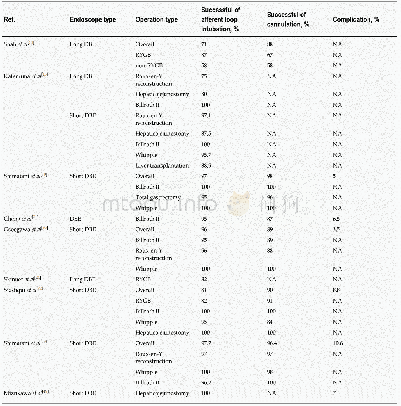《Table 6 Success rates of double balloon enteroscope, single balloon enteroscope, and spiral enteros
 提示:宽带有限、当前游客访问压缩模式
提示:宽带有限、当前游客访问压缩模式
本系列图表出处文件名:随高清版一同展现
《Current status of endoscopic retrograde cholangiopancreatography in patients with surgically altered anatomy》
DBE:Double balloon enteroscope;SBE:Single balloon enteroscope;SE:Spiral enteroscope;RYGB:Roux-en-Y gastric bypass.
Papillary intervention is important and performed prior to stone extraction or other therapeutic procedures.A common technique is endoscopic sphincterotomy(EST),but in cases of surgically altered anatomy,it is difficult to keep the EST knife in the proper direction and control limit size of cutting because of the reverse position of the papilla,difficult scope maneuverability,and improper accessories.Many techniques can facilitate easier EST,such as use of an S-shaped sphincterotome,rotatable sphincterotome,push-type sphincterotome,and needle-knife sphincterotomy(either free-hand or over a biliary stent).The DBE working channel is located at the 6 to 7o’clock position,and the papilla needs to be brought to the 6 o’clock position for safe fixation.Conversely,the SBE working channel is located at 8 to 9 o’clock,making it more difficult to fix the papilla;additionally,the cutting should be directed toward 5-o’clock.If EST is too high-risk,endoscopic papillary balloon dilatation is the first option because of its low risk of bleeding and perforation.This technique is suitable for small and multiple CBD stones because of the small balloon diameter(6-8 mm)[41].For large and multiple CBD stones,endoscopic papillary large balloon dilatation(EPLBD)(diameter,12-18 mm) has a satisfactory success rate even when not combined with EST,and there is no significant difference in post-ERCP pancreatitis.The main reason for performing EPLBD is to avoid additional therapeutic procedures for stone extraction.The stone clearance rate by EPLBD alone is high(Table 7);thus,EPLBD alone and EST plus EPLBD both have a higher therapeutic success rate than EST alone.Teoh et al[42]reported equal efficacy for removal of bile duct stones between EST alone and EST followed by EPLBD,which decreased the bleeding and perforation rates in the EPLBD group.In their systematic review,Kim et al[43]found that the overall success rate was 96.5%in EST with EPLBD and 97.2%in EPLBD alone with no significant difference.EPLBD alone is effective and safe for stone removal after Billroth II reconstruction with a first-session success rate of 92.5%[44].EPLBD can be used alone for papillary intervention to decrease EST-related complications such as bleeding and perforation,but caution is still needed because of possible post-ERCP pancreatitis.
| 图表编号 | XD0087246000 严禁用于非法目的 |
|---|---|
| 绘制时间 | 2019.07.14 |
| 作者 | Chonlada Krutsri、Mitsuhiro Kida、Hiroshi Yamauchi、Tomohisa Iwai、Hiroshi Imaizumi、Wasaburo Koizumi |
| 绘制单位 | Department of Surgery, Faculty of Medicine, Ramathibodi Hospital, Mahidol University、Department of Gastroenterology, Graduate School of Medicine, Kitasato University Hospital、Department of Gastroenterology, Graduate School of Medicine, Kitasato University |
| 更多格式 | 高清、无水印(增值服务) |
查看“Table 6 Success rates of double balloon enteroscope, single balloon enteroscope, and spiral enteroscope in surgically al”的人还看了
-

- Table 4 Empty stalk rate, double ear rate, lodging rate, and lodging and stem broken rate of maize by different treatmen
-

- Table 1 Success rates of conventional duodenoscope and forward-view endoscope in Billroth II operation
-

- Table 4 Success rates of spiral enteroscope-assisted endoscopic retrograde cholangiopancreatography in surgically altere





